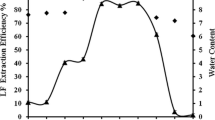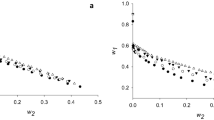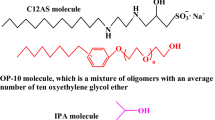Abstract
In this study water solubility curves were constructed and calorimetric measurements obtained for reverse micellar systems consisting of an alcohol (isopropanol or butanol), surfactant (AOT) and organic solvent (isooctane or hexane). Also evaluated were the effects of alcohol and solvent type and surfactant concentration on the extraction of the α-lactalbumin (α–la). From the obtained solubility diagrams for ternary systems, it was concluded that isooctane presented the highest water solubility capacity in the center of the micelle systems with hexane, since isooctane has greater molecular volume and greater effect of the surfactant aggregation number. With respect to the alcohols, it was observed that isopropanol and butanol act in the system as a co-surfactant, since they prefer to adsorb at the water/solvent interface. It was also verified that butanol improved water solubility inside the reverse micellar due to its contribution to increase the critical packing parameter. The amount of α-la extracted increased proportionally with the AOT concentration for systems with isooctane and hexane. However, for systems with the latter solvent, the concentration of extracted protein first increases and then decreases. The extraction power of reverse micellar systems with isooctane was influenced by the type of alcohol with butanol showing better results. For systems containing hexane there was no effect of the alcohol added to the system on extraction power of α-lactalbumin.







Similar content being viewed by others
References
Kinsella JE, Whitehead DM. Proteins in Whey: Chemical, Physical, and Functional Properties. In: John EK, editor. Advances in Food and Nutrition Research. Massachusetts: Academic Press; 1989.
Tarrega A, Ramírez-Sucre MO, Vélez-Ruiz JF, Costell E. Effect of whey and pea protein blends on the rheological and sensory properties of protein-based systems flavoured with cocoa. J Food Eng. 2012;109:467–74.
Childs JL, Yates MD, Drake MA. Sensory properties of meal replacement bars and beverages made from whey and soy proteins. J Food Sci. 2007;72:S425–34.
Pacheco MTB, Antunes AEC. Valdemiro C. Sgarbieri: Protein Research Progress; 2008. p. 117.
Boaglio A, Bassani G, Picó G, Nerli B. Features of the milk whey protein partitioning in polyethyleneglycol-sodium citrate aqueous two-phase systems with the goal of isolating human alpha-1 antitrypsin expressed in bovine milk. J Chromatogr B. 2006;837:18–23.
Mokhtarani B, Mortaheb HR, Mafi M, Amini MH. Partitioning of α-lactalbumin and β-lactoglobulin in aqueous two-phase systems of polyvinylpyrrolidone and potassium phosphate. J Chromatogr B. 2011;879:721–6.
Lecoeur M, Gareil P, Varenne A. Separation and quantitation of milk whey proteins of close isoelectric points by on-line capillary isoelectric focusing—Electrospray ionization mass spectrometry in glycerol–water media. J Chromatogr A. 2010;1217:7293–301.
Marques DP, Custódio MF, Goulart AJ, Giordano RC, Giordano RLC, Monti R. Whey proteins separation by DEAE-Trisacryl. Alimentos e Nutrição Araraquara. 2005;16:17–20.
Mathew DS, Juang R-S. Role of alcohols in the formation of inverse microemulsions and back extraction of proteins/enzymes in a reverse micellar system. Sep Purif Technol. 2007;53:199–215.
Tolkach A, Kulozik U. Fractionation of whey proteins and caseinomacropeptide by means of enzymatic crosslinking and membrane separation techniques. J Food Eng. 2005;67:13–20.
Perry RH, Donwa G, Maloney JOH. Perry’s chemical engineers’ handbook. New York: McGraw-Hill Professional Publishing; 1997.
Liu Y, Dong X, Sun Y. New development of reverse micelles and applications in protein separation and refolding. Chin J Chem Eng. 2008;16:949–55.
Kadam KL. Reverse micelles as a bioseparation tool. Enzyme Microb Technol. 1986;8:266–73.
Krishna SH, Srinivas N, Raghavarao K, Karanth N. Reverse micellar extraction for downstream processing of proteins/enzymes. In: Dutta NN, editor. History and trends in bioprocessing and biotransformation. Berlin: Springer; 2002.
Hebbar HU, Raghavarao KSMS. Extraction of bovine serum albumin using nanoparticulate reverse micelles. Process Biochem. 2007;42:1602–8.
Sun X-H, Zhu K-X, Zhou H-M. Protein extraction from defatted wheat germ by reverse micelles: optimization of the forward extraction. J Cereal Sci. 2008;48:829–35.
Zhang W, Liu H, Chen J. Forward and backward extraction of BSA using mixed reverse micellar system of CTAB and alkyl halides. Biochem Eng J. 2002;12:1–5.
Hasmann FA, Cortez DV, Gurpilhares DB, Roberto IC, Pessoa Júnior A. Micelas reversas de lecitina de soja: uma alternativa para purificação de proteínas. Revista Brasileira de Ciências Farmacêuticas. 2007;43:481–7.
Chen Y-L, Su C-K, Chiang B-H. Optimization of chitosanases produced by Bacillus cereus. Process Biochem. 2006;41:752–8.
Reis MFT, Bonomo RCF, Souza AO, Silva LHM, Veloso CM, Minim LA, Fontan RCI. Calorimetric studies of microemulsion systems with lecithin, isooctane and butanol. Food Res Int. 2012;49:672–6.
Liu D, Ma J, Cheng H, Zhao Z. Conducting properties of mixed reverse micelles. Colloids Surf A. 1999;148:291–8.
Eicke H-F. Surfactants in nonpolar solvents. Berlin Heidelberg: Springer; 1980.
Israelachvili JN. Intermolecular and surface forces/Jacob N. London: Academic Press; 1991.
Author information
Authors and Affiliations
Corresponding author
About this article
Cite this article
Gomes, G.M.S., Bonomo, R.C.F., Veloso, C.M. et al. Acquisition of Water Solubility Diagrams in Ternary Systems (AOT/Organic Solvent/Alcohol) and Extraction of α-Lactalbumin Using Reverse Micellar Systems. J Surfact Deterg 20, 831–841 (2017). https://doi.org/10.1007/s11743-017-1960-x
Received:
Accepted:
Published:
Issue Date:
DOI: https://doi.org/10.1007/s11743-017-1960-x




